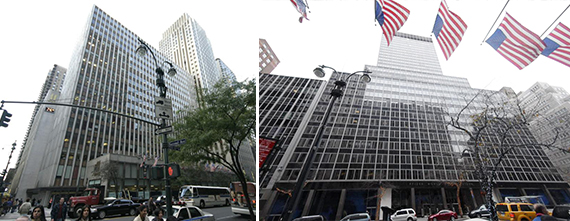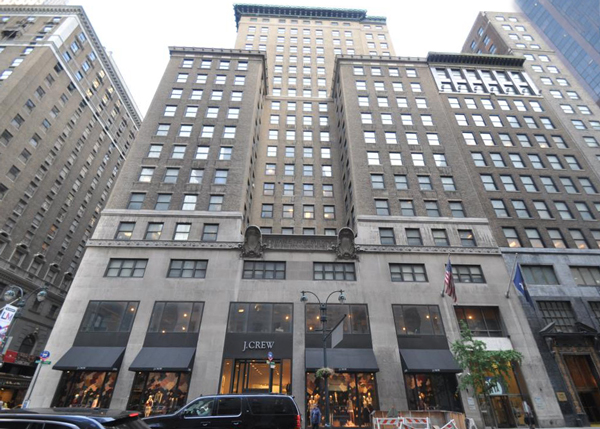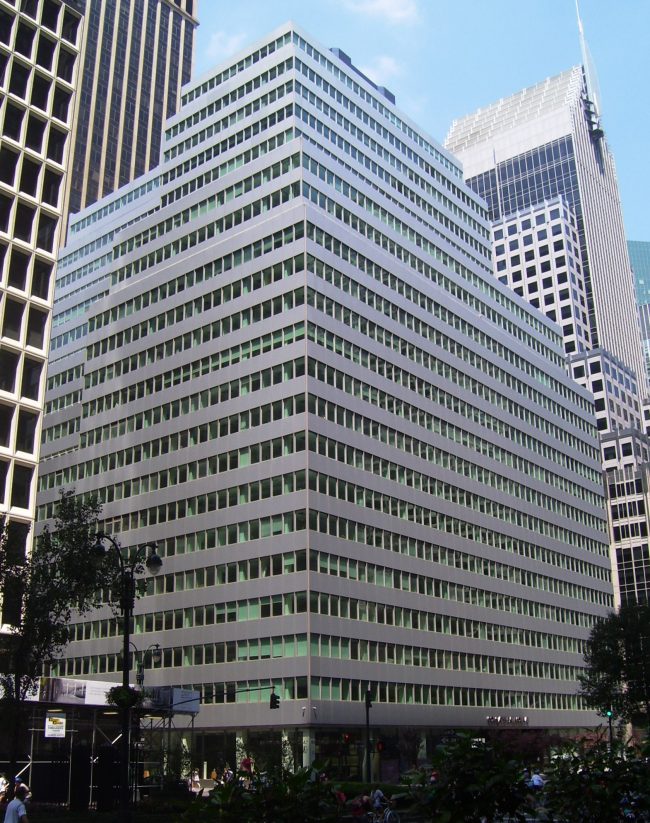In August 2016, the Department of City Planning released a list of 16 properties it predicted might take advantage of a massive rezoning of Midtown East. On Wednesday, JPMorgan Chase announced that its headquarters at 270 Park Avenue — a property that didn’t appear on the city’s list — would be the inaugural commercial phoenix: The 58-year-old tower will be torn down and a younger, taller one will rise in its place.
City officials billed the news as a triumph, as proof that the rezoning of 78 blocks — approved in August — was already proving to be a success. The project is expected to span 2.5 million square feet and stand roughly 1,200 feet tall. The tower will be about 1 million square feet larger than the bank’s current headquarters.
The Department of City Planning estimated that roughly 6.5 million square feet of new office space will be added to the neighborhood thanks to the rezoning, meaning that there’s another 5.5 million or so to go.
Based on information available (such as, what properties stand to gain by redeveloping, how recently they’ve renovated and whether they’ve changed hands recently) and industry chatter, we broke down which addresses might see a new building thanks to the rezoning:

218 and 235 East 42nd Street
1) Pfizer headquarters, 219 East 42nd Street and 235 East 42nd Street
Shortly after the City Council signed off on the Midtown East rezoning, Pfizer announced that it planned to sell its headquarters and move to Tishman Speyer’s Hudson Yards office tower, the Spiral. Negotiations appear to be ongoing, and it’s not clear if Pfizer’s found a prospective buyer, but if these deals go through, the new owner has a few options.
The rezoning changes allowed floor area ratio (FAR) on the site to jump from 10 to 15. This means that if the owner of the buildings decides to knock down the current towers and rebuild a modern office, they will be able to build towers with an FAR of 15 without contributing to the public improvement funds. Any size above that — up to a FAR of 21.6 — would require the owners to buy air rights from a landmarked air rights site nearby. Leading up to the rezoning, this was a point of contention for some community members who felt it gave Pfizer an unfair advantage.
2) MTA headquarters, 341-347 Madison Avenue
This property would technically fall under the Vanderbilt Corridor rezoning, which was the precursor to the Midtown East rezoning. The MTA has been trying to find someone to redevelop the site for several years. Boston Properties came close to signing a 99-year lease in 2016, in which the real estate investment trust agreed to build an office tower that would span between 601,224 and 751,530 square feet.
But the deal was ensnared by a city and state dispute. City officials weren’t happy that the real estate investment trust would get to skip out on hundreds of millions of dollars in property taxes since the company would instead provide payments in lieu of taxes (PILOTS) to the MTA. The PILOT payments were estimated to be worth $1 billion over the course of the 99-year-lease. The Wall Street Journal reported in February 2016 that the deal was put on hold. According to the MTA, the project is still in play.
“Boston Properties is preparing plans and environmental documents required to be completed prior to starting a public land use review process,” an MTA spokesperson said in a statement. Representatives for Boston Properties didn’t return a message seeking comment.
3) W Hotel New York, 541 Lexington Avenue
The Real Deal reported on Wednesday that Capstone Equities was in-contract to buy the W Hotel New York for $190 million. The property is one of the 16 sites identified by the city as prime for redevelopment and stands to gain some 279,613 square feet. The city’s report envisioned this building as a mostly-office building with a small amount of retail.
Capstone could enlarge the 15-story building by adding square footage that would be dedicated to office use. To build a new hotel in the district, developers must receive a special permit, so if Capstone were to knock down the existing building, the company could build office as of right but would require a special permit to build any hotel space.
This 14-story office building was constructed in 1955 and is listed among one of the city’s projected sites. Under the rezoning, the owners, Tishman Speyer, could add 333,455 square feet to its existing 645,483. The building’s facade was renovated in 2000 and a massive interior renovation was done prior to that. A representative for Tishman, which is rumored to be the lead developer on the 270 Park development, declined to comment.
5) 45 East 45th Street, Roosevelt Hotel
Though groups advocated for this hotel to be landmarked ahead of the rezoning, the Roosevelt Hotel — which opened in 1924 — didn’t make the list of 12 buildings approved in 2016. The hotel also falls within the Vanderbilt Corridor, which would allow for an office tower of nearly 1 million square feet. The owner, state-run Pakistan International Airlines, tried to sell the historic hotel in 2007, but took it off the market in 2011, the Commercial Observer reported. Since the property underwent a massive renovation not too long ago, the owners could opt to enlarge the property with office space or wait a little longer before tearing the structure down (though groups are still pushing for the property to be landmarked). As a long-term asset, though, the ability to build a massive office tower in the future is a pretty compelling selling point.
Disclaimer: There are likely smaller hotels that may consider converting their site (the Affinia Hotel at 155 East 50th Street comes to mind), but this list focuses on larger properties. The list also focuses on individual buildings, rather than assemblages, which the city predicts could play a major role in the neighborhood’s makeover. Our crystal ball, alas, doesn’t see that far. Tenants in some of these buildings, as well as shared ownership of these properties, will also have a significant impact on what buildings are renovated or torn down.


